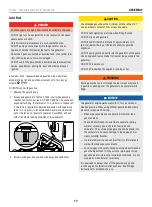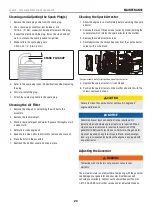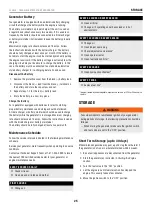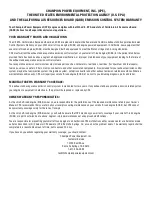
100814 - 7500W ELEcTRic START GENERATOR
OPERATiON
21
WARNiNG
Always remember to plug your appliances directly into the
generator and do not plug the generator power cord into any
electrical outlet or connect to the circuit breaker panel in your
home. Connecting a generator to your home’s electric utility
company’s power lines, or to another power source, called
‘backfeeding’ is a dangerous practice that is illegal in many
states and municipalities.
This action if done incorrectly could damage your generator,
appliances and could cause serious injury or death to you
or a utility worker when attempting to restore power during
an outage occurrence in the neighborhood who may then
unexpectedly encounter high voltage on the utility line and
suffer a fatal shock.
Whether injuries occur or not, if installed incorrectly and not to
applicable laws and codes, you may be subject to fines or the
utility company may disconnect your home power should this
practice be found in your home.
If the generator will be connected to a building electrical
system, those connections must isolate the generator power
from the utility power. You are responsible for ensuring your
generator’s electricity does not backfeed into the electric
utility power lines. These connections must comply with all
applicable laws and codes – Consult your local utility company
or a qualified electrician to properly install this connection.
Do Not Overload Generator
Capacity
Follow these simple steps to calculate the running and starting
watts necessary for your purposes:
1. Select the electrical devices you plan on running at the same
time.
2. Total the running watts of these items. This is the amount of
power you need to keep your items running.
3. Identify the highest starting wattage of all devices identified
in step 1. Add this number to the number calculated in step 2.
Starting wattage is the extra burst of power needed to start
some electric driven equipment. Following the steps listed
under “Power Management” will guarantee that only one
device will be starting at a time.
Power Management
Use the following formula to convert voltage and amperage to
watts:
Volts × Amps = Watts
To prolong the life of your generator and attached devices, follow
these steps to add electrical load:
1. Start the generator with no electrical load attached.
2. Allow the engine to run for several minutes to get up to
temperature.
3. Make sure all circuit breakers are set to the run position.
4. Plug in and turn on the first item. It is best to attach the item
with the largest load first.
5. Allow the engine to stabilize.
6. Plug in and turn on the next item.
7. Allow the engine to stabilize.
8. Repeat steps 5-6 for each additional item.
NOTicE
Never exceed the specified capacity when adding loads to the
generator.
Gfci
Your generator is equipped with ground fault circuit interrupter
(GFCI) receptacles. In the event of a ground fault, a GFCI trips
automatically to stop the flow of electricity and prevent serious
injury. The green indicator light (A) on the receptacle will also
turn off. Press the “RESET” (B) button located on the front of the
receptacle to restore flow of electricity. The indicator light will also
turn back on. GFCI does not protect against circuit overloads.
To ensure proper operation of the GFCI duplex, perform this test
monthly:
1. With the generator running, plug a lamp into the GFCI
receptacle. Turn the lamp on.
2. Press the “TEST” (C) button located on the front of the
receptacle to trip the device. This should immediately stop
the flow of electricity and shut off the lamp. If the electricity
is not stopped, do not use this receptacle until it has been
serviced or replaced.
3. Press the “RESET” button located on the front of the
receptacle to restore the flow of electricity. If the indicator
light does not come back on or if the GFCI cannot be reset
then it must be replaced.
A
c
b












































